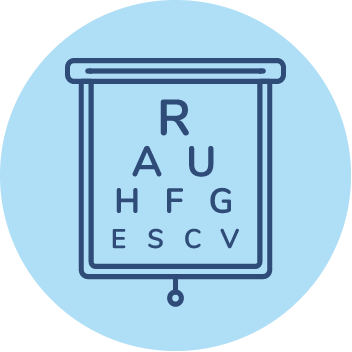ABOUT NMOSD
Neuromyelitis optica spectrum disorder (NMOSD), also known as Devic’s disease, is a rare and debilitating autoimmune disease caused by inflammation in the central nervous system (the optic nerve, brain stem and spinal cord). If left untreated, this inflammation can cause repeat attacks and permanent disability, such as blindness and paralysis.
Who NMOSD Affects

40 years
The median age of onset is 40 years, but NMOSD can occur at any age.1-3

Women
Women may be nine times more likely to be impacted versus men.4

Asian & African American
There is a two- to three-fold higher prevalence in Asian and African American populations.5,6
Detecting NMOSD
NMOSD can be difficult to diagnose and is often mistaken for multiple sclerosis (MS).
Specific testing for the antibodies causing the inflammation that led to NMOSD attacks can aid in diagnosis and help determine treatment options.8,9 Request a blood test for anti-aquaporin-4 (AQP4-IgG) antibodies with your doctor to confirm that you have NMOSD.
If antibodies against AQP4 are found in your blood, it will confirm you have NMOSD and not MS.9 AQP4 antibodies are present in up to 80% of NMOSD cases, so testing for this antibody is essential to receiving a diagnosis.10

The Importance of Early and Accurate Diagnosis
It’s important to talk about NMOSD symptoms and testing, because NMOSD and MS have different treatments. Some MS treatments can make NMOSD symptoms worse, so it’s important to get an accurate diagnosis and explore the right treatment options.

Within one year, 60% of those with NMOSD will have repeat attacks with no NMOSD treatment.11
After five years, four out of 10 of those with NMOSD may be legally blind in at least one eye, and two out of 10 may require a walker.12
Of those with optic neuritis (or vision challenges), 67% had partial or no recovery following an NMOSD attack.4
Differences Between NMOSD and MS
NMOSD
- A single attack can cause disability
- Attacks are usually more severe and can result in permanent disability
- Attacks may affect both eyes at the same time
- Hiccups, nausea and vomiting are more common symptoms
- AQP4 antibody positive in a blood test
MS
- Several individual attacks typically cause disability over time
- Attacks are typically less severe and can result in better recovery
- Usually affects one eye at a time
- Cognitive changes, such as changes in memory, reasoning and problem-solving, are more common over time
- AQP4 antibody negative in a blood test
Know Your Symptoms
People with NMOSD can experience a wide range of seemingly unconnected symptoms.7 If you are experiencing any new or worsening symptoms, contact your doctor immediately as it may signal a new attack.
Discover More From NMOSD Patient Advocacy Groups

10 Steps Forward
With insights from others who live with or care for someone with NMOSD, these 10 steps may help you navigate the path forward when newly diagnosed.
Newly Diagnosed With NMOSD
Connect with specialists, advocates and support groups, and find information about therapies and medical cost assistance.
NMO Resources App
You can download a free app to learn more about NMOSD, listen to videos, find answers to frequently asked questions, connect with support groups and more.
Simplifying the Science of NMO Video
In this video (and transcript) from an NMO Patient Day, Dr. Michael Yeamen breaks down how your cells and immune system are influenced by NMOSD.
Tools for Download
These resources include a Patient Resource Guide with information on the history and treatment of NMOSD and a NMO/MS Brochure available in 12 languages.

ABCs of NMOSD Podcast
This series brings together the latest research and clinical knowledge on NMOSD, from diagnosis and treatment to what it’s like to live with NMOSD.
NMOSD Information Sheet
This resource has been reviewed by members of SRNA’s Medical and Scientific Council to provide an overview of NMOSD, signs and symptoms, diagnosis, prognosis and more.

From the Experts Video Series
These educational videos share information about topics like nerve pain, spasticity, pregnancy, COVID-19 and insurance — all through the lens of NMOSD.
NMOSD Resources
This collection of resources, available in 23 languages, includes information on clinical trials, financial support, steroids and seronegative NMOSD.
What to Know About NMO
These questions and answers, available in 23 languages, cover important information about diagnosis, symptoms and available treatments.
REFERENCES
1. Ajmera MR, Boscoe A, Mauskopf J, Candrilli SD, Levy M. Evaluation of comorbidities and health care resource use among patients with highly active neuromyelitis optica. J Neurol Sci. 2018;384:96-103. doi:10.1016/j.jns.2017.11.022 2. Neuromyelitis optica spectrum disorder (NMOSD). National Multiple Sclerosis Society. Published 2022. Accessed November 4, 2022. https://www.nationalmssociety.org/What-is-MS/Related-Conditions/Neuromyelitis-Optica-(NMO) 3. Mealy MA, Wingerchuk DM, Greenberg BM, Levy M. Epidemiology of neuromyelitis optica in the United States: A multicenter analysis. Arch Neurol. 2012;69(9):1176-1180. doi:10.1001/archneurol.2012.314 4. Jarius S, Ruprecht K, Wildemann B, et al. Contrasting disease patterns in seropositive and seronegative neuromyelitis optica: A multicenter study of 175 patients. J Neuroinflammation. 2012;9(14):1-17. doi:10.1186/1742-2094-9-14 5. Flanagan EP, Cabre P, Weinshenker BG, et al. Epidemiology of aquaporin-4 autoimmunity and neuromyelitis optica spectrum. Ann Neurol. 2016;79(5):775-783. doi:10.1002/ana.24617 6. Bukhari W, Prain KM, Waters P, et al. Incidence and prevalence of NMOSD in Australia and New Zealand. J Neurol Neurosurg Psychiatry. 2017;0:1-7. doi:10.1136/jnnp-2016-314839 7. Beekman J, Keisler A, Pedraza O, et al. Neuromyelitis optica spectrum disorder: Patient experience and quality of life. Neurol Neuroimmunol Neuroinflamm. 2019;6(4):e580. doi:10.1212/NXI.0000000000000580 8. Borisow N, Mori M, Kuwabara S, Scheel M, Paul F. Diagnosis and treatment of NMO spectrum disorder and MOG-encephalomyelitis. Front Neurol. 2018;9(888):1-15. doi:10.3389/fneur.2018.00888 9. Wingerchuk DM, Banwell B, Bennett JL, et al. International consensus diagnostic criteria for neuromyelitis optica spectrum disorders. Neurology. 2015;85:177-189. doi:10.1212/WNL.0000000000001729 10. Hamid SHM, Whittam D, Mutch K, et al. What proportion of AQP4-IgG-negative NMO spectrum disorder patients are MOG-IgG positive? A cross sectional study of 132 patients. J Neurol. 2017;264:2088-2094. doi:10.1007/s00415-017-8596-7 11. Wingerchuk DM, Lennon VA, Lucchinetti CF, Pittock SJ, Weinshenker BG. The spectrum of neuromyelitis optica. Lancet Neurol. 2007;6:805-815. doi:10.1016/S1474-4422(07)70216-8 12. Jiao Y, Fryer JP, Lennon VA, et al. Updated estimate of AQP4-IgG serostatus and disability outcome in neuromyelitis optica. Neurology. 2013;81:1197-1204. doi:10.1212/WNL.0b013e3182a6cb5c
Hear NMOSD Stories
People living with NMOSD and their care partners share challenges, triumphs and advocate for their health.
Find Out If Your NMOSD Is Under Control
Take a short quiz to help navigate a conversation with your doctor.

Receive the latest NMOSD information, resources and unstoppable stories sent directly to your email.

